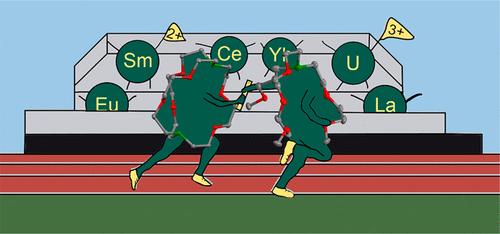当前位置:
X-MOL 学术
›
Inorg. Chem.
›
论文详情
Our official English website, www.x-mol.net, welcomes your
feedback! (Note: you will need to create a separate account there.)
Expanding the Coordination of f-Block Metals with Tris[2-(2-methoxyethoxy)ethyl]amine: From Molecular Complexes to Cage-like Structures
Inorganic Chemistry ( IF 4.3 ) Pub Date : 2023-11-28 , DOI: 10.1021/acs.inorgchem.3c02752 Sergely Steephen Bokouende 1 , D Nuwangi Kulasekara 1 , Sara A Worku 1 , Cassandra L Ward 2 , Aravind B Kajjam 1 , Jacob C Lutter 1 , Matthew J Allen 1
Inorganic Chemistry ( IF 4.3 ) Pub Date : 2023-11-28 , DOI: 10.1021/acs.inorgchem.3c02752 Sergely Steephen Bokouende 1 , D Nuwangi Kulasekara 1 , Sara A Worku 1 , Cassandra L Ward 2 , Aravind B Kajjam 1 , Jacob C Lutter 1 , Matthew J Allen 1
Affiliation

|
Low-valent f-block metals have intrinsic luminescence, electrochemical, and magnetic properties that are modulated with ligands, causing the coordination chemistry of these metals to be imperative to generating critical insights needed to impact modern applications. To this end, we synthesized and characterized a series of twenty-seven complexes of f-metal ions including EuII, YbII, SmII, and UIII and hexanuclear clusters of LaIII and CeIII to study the impact of tris[2-(2-methoxyethoxy)ethyl]amine, a flexible acyclic analogue of the extensively studied 2.2.2-cryptand, on the coordination chemistry and photophysical properties of low-valent f-block metals. We demonstrate that the flexibility of the ligand enables luminescence tunability over a greater range than analogous cryptates of EuII in solution. Furthermore, the ligand also displays a variety of binding modes to f-block metals in the solid state that are inaccessible to cryptates of low-valent f-block metals. In addition to serving as a ligand for f-block metals of various sizes and oxidation states, tris[2-(2-methoxyethoxy)ethyl]amine also deprotonates water molecules coordinated to trivalent triflate salts of f-block metal ions, enabling the isolation of hexanuclear clusters containing either LaIII or CeIII. The ligand was also found to bind more tightly to YbII and UIII in the solid state compared to 2.2.2-cryptand, suggesting that it can play a role in the isolation of other low-valent f-block metals such CfII, NpIII, and PuIII. We expect that our findings will inspire applications of tris[2-(2-methoxyethoxy)ethyl]amine in the design of light-emitting diodes and the synthesis of extremely reducing divalent f-block metal complexes that are of interest for a wide range of applications.
中文翻译:

扩大 f 区金属与三[2-(2-甲氧基乙氧基)乙基]胺的配位:从分子配合物到笼状结构
低价 f 区金属具有通过配体调节的固有发光、电化学和磁性特性,导致这些金属的配位化学对于产生影响现代应用所需的关键见解至关重要。为此,我们合成并表征了一系列 27 种 f 金属离子络合物,包括 Eu II 、 Yb II 、Sm II和 U III以及 La III和 Ce III六核簇,以研究 tris[2] 的影响。 -(2-甲氧基乙氧基)乙基]胺,一种广泛研究的 2.2.2-穴状配体的灵活无环类似物,研究低价 f 嵌段金属的配位化学和光物理性质。我们证明,与溶液中类似的 Eu II穴状化合物相比,配体的灵活性使得发光可调范围更大。此外,该配体还表现出多种与固态 f 区金属的结合模式,这是低价 f 区金属穴状化合物无法达到的。除了充当各种尺寸和氧化态的 f 区金属的配体外,三[2-(2-甲氧基乙氧基)乙基]胺还可使与 f 区金属离子的三价三氟甲磺酸盐配位的水分子去质子化,从而能够分离含有 La III或 Ce III的六核团簇。与 2.2.2-穴状配体相比,该配体还被发现在固态下与 Yb II和 U III 的结合更紧密,这表明它可以在分离其他低价 f 区金属(如 Cf II)中发挥作用。 Np III和 Pu III 。 我们希望我们的研究结果将激发三[2-(2-甲氧基乙氧基)乙基]胺在发光二极管设计和合成极还原性二价f-嵌段金属配合物中的应用,这些金属配合物对广泛的应用感兴趣。应用程序。
更新日期:2023-11-28
中文翻译:

扩大 f 区金属与三[2-(2-甲氧基乙氧基)乙基]胺的配位:从分子配合物到笼状结构
低价 f 区金属具有通过配体调节的固有发光、电化学和磁性特性,导致这些金属的配位化学对于产生影响现代应用所需的关键见解至关重要。为此,我们合成并表征了一系列 27 种 f 金属离子络合物,包括 Eu II 、 Yb II 、Sm II和 U III以及 La III和 Ce III六核簇,以研究 tris[2] 的影响。 -(2-甲氧基乙氧基)乙基]胺,一种广泛研究的 2.2.2-穴状配体的灵活无环类似物,研究低价 f 嵌段金属的配位化学和光物理性质。我们证明,与溶液中类似的 Eu II穴状化合物相比,配体的灵活性使得发光可调范围更大。此外,该配体还表现出多种与固态 f 区金属的结合模式,这是低价 f 区金属穴状化合物无法达到的。除了充当各种尺寸和氧化态的 f 区金属的配体外,三[2-(2-甲氧基乙氧基)乙基]胺还可使与 f 区金属离子的三价三氟甲磺酸盐配位的水分子去质子化,从而能够分离含有 La III或 Ce III的六核团簇。与 2.2.2-穴状配体相比,该配体还被发现在固态下与 Yb II和 U III 的结合更紧密,这表明它可以在分离其他低价 f 区金属(如 Cf II)中发挥作用。 Np III和 Pu III 。 我们希望我们的研究结果将激发三[2-(2-甲氧基乙氧基)乙基]胺在发光二极管设计和合成极还原性二价f-嵌段金属配合物中的应用,这些金属配合物对广泛的应用感兴趣。应用程序。






























 京公网安备 11010802027423号
京公网安备 11010802027423号